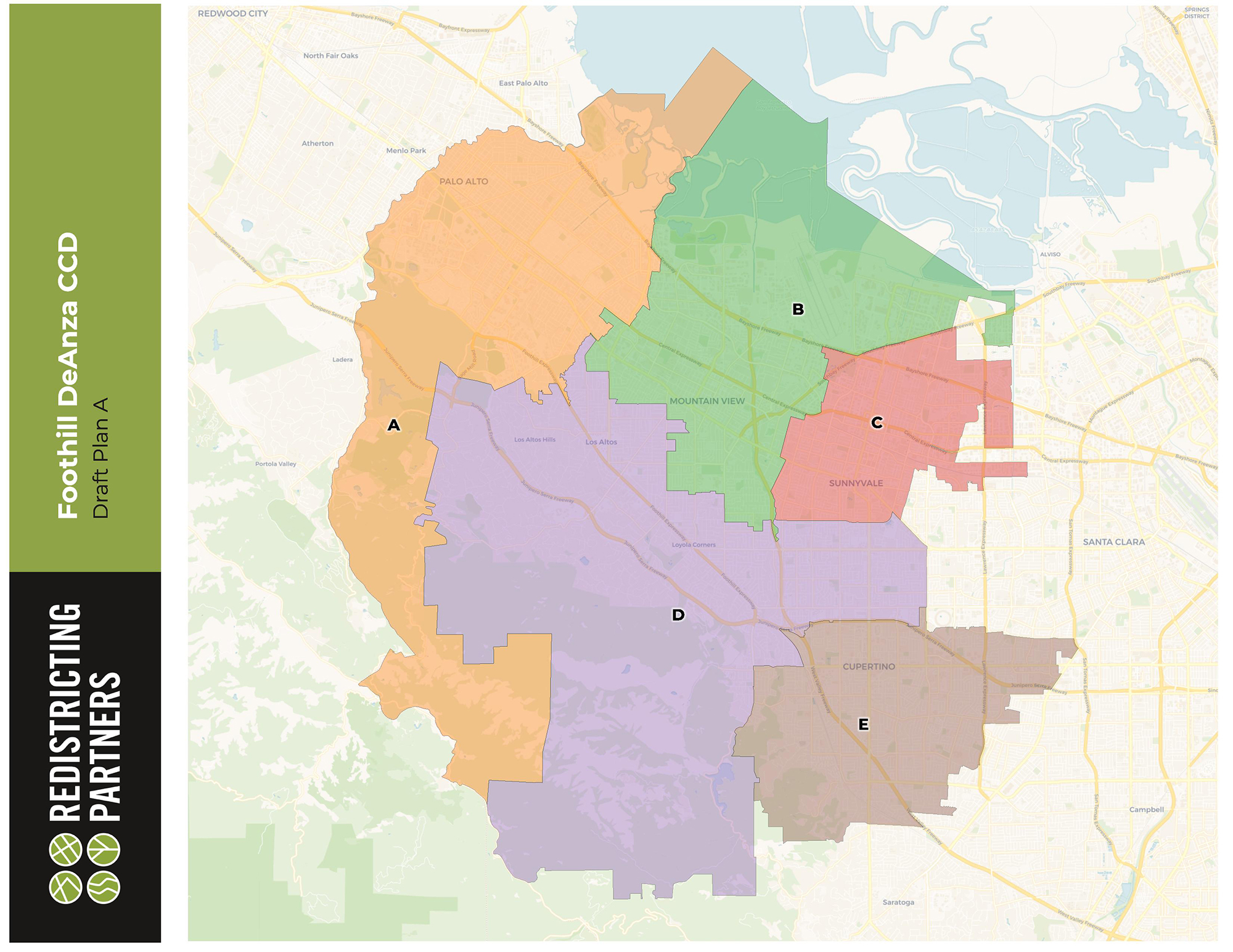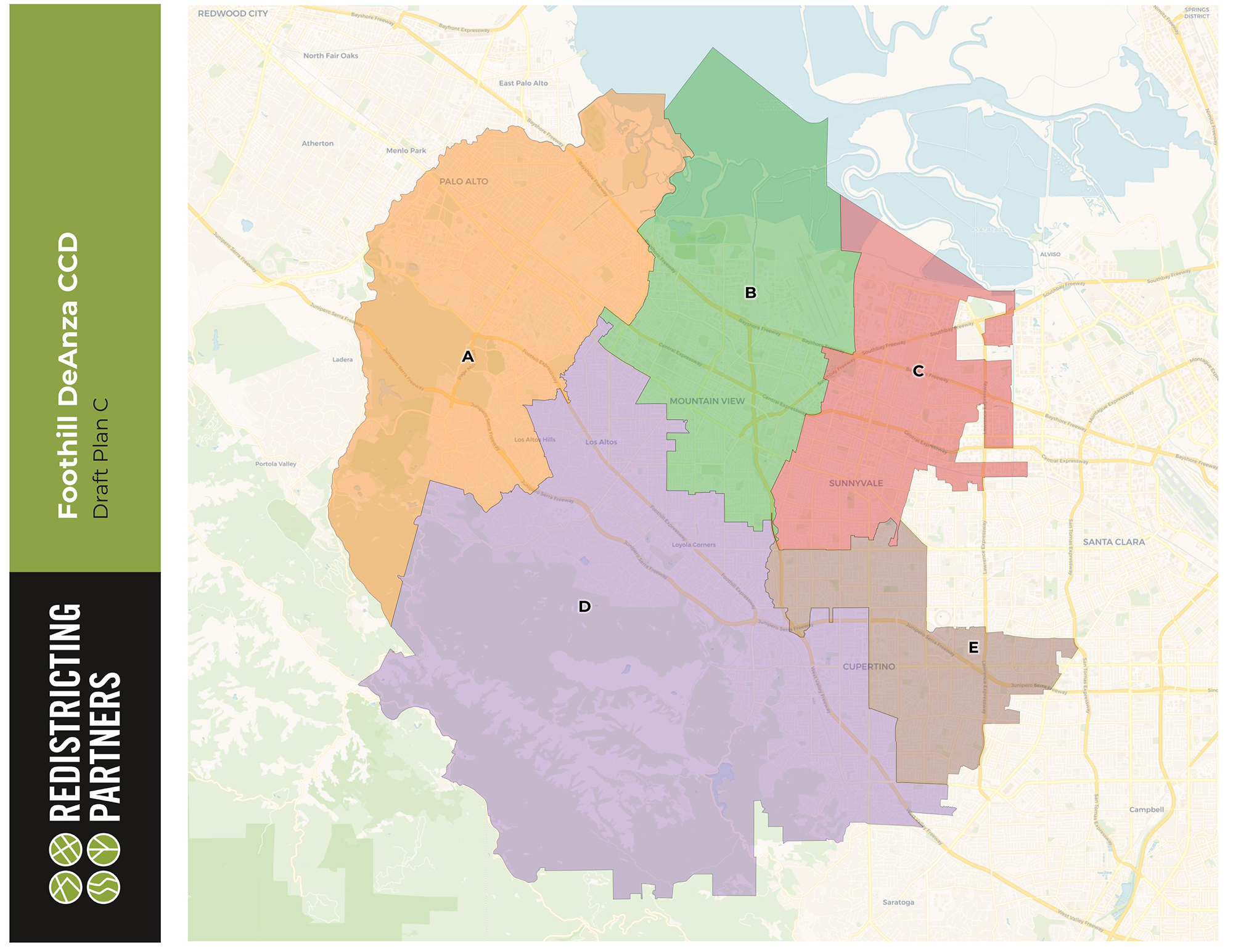The future of elections in the Foothill-De Anza Community College District took shape Monday night, Jan. 10, when the board of trustees selected a single map of election areas to move forward for a final vote next month.
The board voted 4-1 to select a map that splits the community college district into sub-areas based on underlying city borders, rather than a map that prioritized K-12 school district boundaries. Trustee Gilbert Wong dissented. The board is slated to take a final vote on Feb. 14.
Foothill-De Anza is in the process of moving from at-large elections to area-based ones. In the current at-large system, voters throughout the district elect the board's five trustees. Under the area-based system, the district will be divided into five geographic regions and voters in each area will vote for a single trustee who lives in that same part of the district. The community college district's boundaries span from Palo Alto down the Peninsula into a small part of San Jose.
The move comes after the district was threatened with a lawsuit in 2019 over claims that the current at-large system leads to racially polarized voting. Rather than go to court, the board voted to switch to area trustee elections. Other governing boards in California have faced similar lawsuits under the California Voting Rights Act.
On Monday night, the board weighed two proposed maps: one which drew districts based on city boundaries (Map A) and another based on school district boundaries (Map C). The trustees generally said either map would be acceptable, but a majority ended up preferring Map A.
"It's largely because I think that's the most comprehensible to members of the public, who know what city they live in," board member Peter Landsberger said.
An outside consultant Foothill-De Anza has hired to guide this process, Redistricting Partners, initially proposed three maps for the board to consider. At a Dec. 13 meeting, the trustees voted to eliminate a map that used a combination of school district and city boundaries, saying it was less clear. Trustee Wong also dissented from that vote.
At Monday's meeting, Wong once again broke from his colleagues, saying he strongly supported Map C and objecting to the way Sunnyvale and Cupertino are split up in Map A. Wong is a former mayor of Cupertino.
Under Map A, Sunnyvale is split between three districts, while in Map C it is largely in two districts, though a small part spills into a third. Cupertino is divided into two districts in both maps, though the dividing line differs.
Wong said he preferred Map C, because it splits Sunnyvale and Cupertino based on school district boundaries, with the Sunnyvale School District almost entirely in one district and the Cupertino Union School District split between two.
"Dividing up those two different cities based on the two elementary school districts makes absolutely more sense than to further divide it into three different districts," Wong said.
Neither map can follow city or school district boundaries perfectly, because the Foothill-De Anza district's 450,000 residents are required to be split roughly evenly between the five trustee areas. Sunnyvale alone has roughly 150,000 residents. Portions of Sunnyvale and Cupertino are also outside the community college district's boundaries altogether.
Wong said that if the trustees moved forward with Map A, he wanted the district's consultant to redraw the map with all of Cupertino in one area. Paul Mitchell of Redistricting Partners said Cupertino couldn't be drawn fully together, although it could theoretically be kept more whole.
All four of the other trustees opposed redoing the maps, with some pointing to the board's initial commitment not to get involved in drawing the lines themselves. If current board members seek re-election, they will run in the trustee areas where they reside, meaning that the way the final map is drawn will affect their electoral prospects.
A representative from the League of Women Voters of Cupertino-Sunnyvale who attended the meeting told the board that trying to redraw the lines would be difficult and require starting all over again. A League of Women Voters representative from the Los Altos-Mountain View area spoke earlier in the meeting, urging the board to more fully discuss their reasoning for which map to choose.
"The League feels that the trustees evaluation of the three maps – A, B and C – was not adequately explored at the Dec. 13 meeting," Sue Graham said.
The board is scheduled to take a final vote on Map A at a Feb. 14 meeting, where they will also decide the sequencing of the elections. Two seats on the board are up for a vote this fall, with the other three in 2024.
For more information, visit fhda.edu/trustee-areas.




Comments